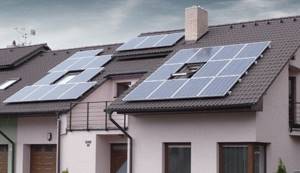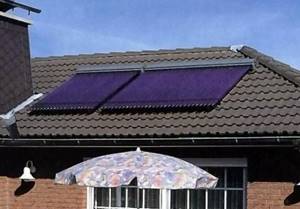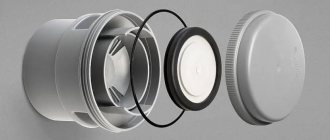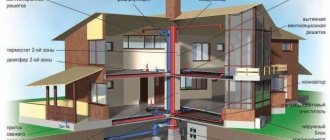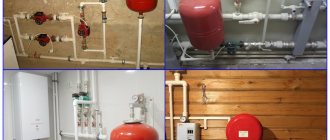How solar collectors work
A solar collector is a functional structure used to generate energy. Its photosensitive elements absorb light to heat the liquid or air inside the tubes.
The principle of operation of a solar collector (SC): the rays of the sun heat the black plates, and the energy is accumulated for domestic needs. The method of obtaining it is environmentally friendly and economical.
The following types of household collectors are distinguished:
- flat;
- vacuum;
- air.
Let's talk more about each of these types below.
Flat
Popular and budget-priced devices. They consist of a flat photosensitive plate connected to heat-conducting pipes, a glass coating, thermal insulation and a metal frame. The plate absorbs sunlight and accumulates thermal energy, which heats the coolant fluid. Unlike other types, they lose a lot of absorbed heat. Ineffective in cloudy weather. High humidity has a bad effect on structural parts.
Vacuum
There are 2 types of vacuum collectors: direct-flow and with indirect heat transfer. The former are used in the warm season, the latter - all seasons. The design is based on a vacuum tube system with a metal rod inside, which contains a coolant fluid. This installation works on the principle of a thermos. Characterized by optimal efficiency.

Air
The principle of operation is similar to flat ones. But air collectors use air as a coolant. Installed for heating houses. Heated air fills the room using air ducts and a fan.
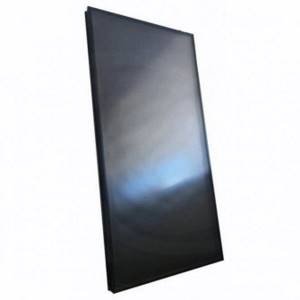
The type of device is chosen based on the purpose of use. The designs are suitable for summer cottages, cottages, village houses and duplexes.
Using solar energy for heating
The spread of solar heating systems for private homes is constantly growing, as it is an innovative technology that uses solar energy. Today, absolutely every owner of a private or country house can install such a system. Note that you will only need to invest financial resources in the purchase of equipment that will be needed to accumulate heat, but you will get the energy itself for free.
Note that the installed system can serve you for more than 25 years, and it will pay for itself in about 3 years if you use it constantly.
Heating a house from the sun can be of two types:
- Based on solar panels.
- Based on solar collectors.
|
|
Solar heating has many advantages:
- Significant savings on fuel costs.
- This is a completely environmentally friendly system.
- Ease of use.
- Prices for photocells are falling, so the cost of equipment and system installation is also falling.
Among the disadvantages are the following:
- When the day is cloudy, significantly less energy will be produced.
- Equipment and installation of such a system is expensive.
- The uninterrupted operation of such a system requires special attention: accurate calculations and correct installation of all elements.
Where to install solar collectors
The main condition for the operation of the collector is an open space where direct sunlight freely reaches at any time of the year. The device is installed in the territories of private houses, where there is no shadow from other buildings and trees. More often, photosensitive plates are mounted on the roof of a building.
A common method is to install several plates, so-called “geofields”. Both pitched and flat roofs are suitable for installation. Due to the large weight of the collector, it is fixed to supporting structures - beams, rafters, etc.
The devices are installed on balconies or horizontal surfaces of the facade. To make it work more efficiently, photosensitive elements in Russia are located strictly on the south side. If they deviate to the west or east, the absorption coefficient of solar rays will decrease.
How to make it yourself
If you have free time and the ability to work with hand tools, you can make a flat solar collector yourself; this will require:
- dark colored water hose (black);
- circulation pump equipped with an electric motor with an operating voltage of 220.0 Volts;
- shaped fittings (for connection to the pump and pool);
- any material available from which you can make a substrate or a box - a box that serves to accommodate a hose twisted into a snail.
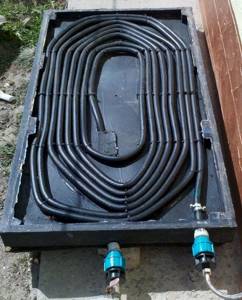
If lumber is available (edged boards, plywood, OSB sheets), a box is made from them, the inner surface of which is painted black.
A hose in the form of a spiral is laid in the internal space, and clamps or clips designed for water pipes can be used to secure it.
Holes are cut in the side walls through which the ends of the hose are brought out.
One end is connected to the circulation pump, and the other is discharged into the pool.
To ensure water heating in a given range in automatic mode, a starter can be installed in the power supply circuit of the circulation pump motor, in the secondary circuit of which a temperature sensor should be connected. The sensor itself should be placed in the pool.
How to calculate collector area
The working surface area of the system is calculated taking into account its type and location features. It should be remembered that the efficiency of the collector depends on the temperature conditions and the amount of solar energy.
Approximate values for summer in Russia per 1 m²: up to 160 kWh per month, the rest of the time - from 20 to 80 kWh.
For hot water supply you will need approximately 100 * 1.16 * 30 = 3.48 kWh. At the same time, 1.16 Wh is the energy that will be needed to heat 1 kg of water by 1 °C.
Heat pumps are used to regulate energy production in hot weather. Also in summer, structures are covered with a thick awning if they generate a lot of energy. The installation plan and area of photosensitive elements are determined individually.
Solar heating
In essence, solar panels are photogenerators of electricity. As the laws of physics tell us, sunlight generates direct current, affecting semiconductor elements. And voltage appears in the solar battery circuits, which is then supplied to objects. A special battery stores energy, which can then be used on cloudy days.

Heating system using solar panels
Heating a private house with solar energy using batteries is best placed on the south side of the roof, and the roof angle should be at least 30 degrees. Experts also recommend taking into account the presence of additional interference - for example, if there are structures or trees nearby, which could subsequently interfere with the functioning of the system. The flow of sun rays should be taken into account: 1000 kW/h per 1 sq.m per year. In this calculation, the solar energy you will receive will be equal to using 100 liters of gas.
The solar battery consists of the following elements:
- Transparent top panel, water or air will circulate inside it, made of glass or plastic.
- A blackened metal surface that absorbs heat from the sun.
- A water tank or a special storage tank where heated liquid or gas goes, after which it enters the batteries.

Sectional view of a solar battery
Solar heating systems for a private home include the following elements:
- Ordinary converter.
- DC to AC converter.
- A sensor that regulates the level of charging and discharging of the battery.
- Battery.
- Power take-off system.
Solar heating of a country house using batteries is used mainly to generate electricity. Therefore, it would be best to install such batteries where electric heating, electric heaters or heated floors are used. When you equip your heating with high-power solar panels, you can supply your home with hot water.
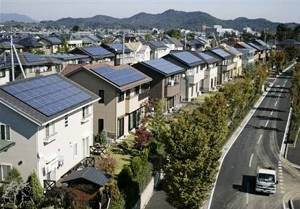
Solar panels have gained great popularity in the world
As for the efficiency of such a system as heating a house with solar energy from batteries, this indicator depends on many factors, the main one of which is the incoming solar energy. If your home is located in the northern latitude, then it is best to use combined types of heating, where solar energy will only be an addition. The same applies to those areas where there is frequent cloudy weather, since at such times the battery power will be very small.
Related Posts
- Economical heating of a private house and apartment
- Leningrad heating system for a private house
- How to make steam heating
- Connection diagrams for bimetallic radiators
- What to do if the bottom of the battery is cold and the top is hot?
- Airborne solar collector
- Water supply collector
- Heating collector: principle of operation, installation and connection rules
- Heating a house without gas or electricity. possible options
- Heating distribution manifold
- A selection of the best alternative heating sources for a private home
- A supply of hot water that is always at hand: how does an electric water heater for heating work?
- How to make geothermal heating at home
- Do-it-yourself heating options for a country house
- Installation and installation of a solid fuel heating boiler
- Cheap and efficient heating option
- Tichelmann loop
- Thermal accumulators for autonomous heating systems
- Heating system of a one-story private house
- Connecting and calculating a buffer tank to a solid fuel boiler
- Hydroarrow: principle of operation, purpose and calculations
- Choosing between metal-plastic and polypropylene pipes
- Using narrow, low and compact heating radiators
- Major heating repairs in an apartment building
- Do-it-yourself air heating: everything about air heating systems
Read with this
- Economical heating of a private house and apartment
- Leningrad heating system for a private house
- How to make steam heating
- Connection diagrams for bimetallic radiators
- What to do if the bottom of the battery is cold and the top is hot?
- Airborne solar collector
- Water supply collector
- Heating collector: principle of operation, installation and connection rules
- Heating a house without gas or electricity. possible options
- Heating distribution manifold
What should be the angle of inclination of the collector?
The installation angle of the flat solar collector depends on the following factors:
- Region of residence. For the southern regions - 30-35°, for the middle zone - from 40°.
- The time of year when the installation is planned to be used (summer or winter season, year-round). For all-season use, choose an angle that is approximately equal to the geographic latitude of the region. In summer this value is reduced by 15°. In winter, on the contrary, they increase.
- Climatic conditions and precipitation. If the solar system is used in winter, the angle of inclination is made steep so that snow does not accumulate on its surface.
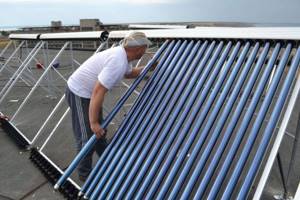
In the accompanying instructions, the manufacturer indicates the optimal angle of inclination for each solar heater. Compliance with all conditions for determining angular inclination values contributes to the most efficient operation of the equipment.
Operating principle and varieties
Collectors capture infrared energy and convert it into heat - simply put, the sun heats their surface. This energy is then transferred to the coolant. This is the basis, this is how any solar collector functions, and the subtleties will depend on its type. They are divided primarily by type of design, into flat and vacuum.
The immediately noticeable part of the flat-plate collector is the panel that absorbs light. It is under a protective coating and can be painted with black paint; often compounds are applied to its surface that increase operational efficiency. Another important part hidden from view is the coolant pipe system.
The design of a flat-plate collector is quite simple, so it is reliable and unpretentious, and at the same time relatively inexpensive - the cost has decreased significantly in the last 5-7 years. Because of this, it is most often preferred. Such collectors can work all year round, but while in summer they are superior to vacuum ones in productivity, then in cold weather they begin to yield.
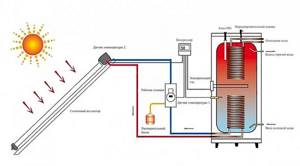
The vacuum manifold is more complex in design. This is a series of vacuum tubes with heat pipes located inside them. Light passes through the transparent surface of the upper tubes, and the vacuum with which they are filled reduces heat loss by 95-97%. The inner tubes are coated with a special compound for more efficient energy capture. When heated, the coolant turns into gas, rises to the top of the tube and gives off heat, after which it condenses and returns down, heats up again, becomes a gas - and so on.
Compared to a flat collector, a vacuum one is inferior in efficiency, while surpassing it in size and weight, but it performs much better in the cold season. Neither poor lighting nor low temperatures will be a hindrance for him. This makes vacuum manifolds very useful for difficult climate conditions, but they are significantly more expensive than flat manifolds.
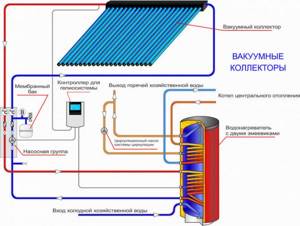
Necessary tools and materials for installing a solar collector
Installation of solar collectors is carried out outdoors. Consequently, the structure itself, the pipeline system and all auxiliary fastenings are subject to environmental damage over time. They may experience corrosion and deformation. Therefore, only stainless materials are used for installation.
To install the solar collector, use the following auxiliary tools:
- crane or lift;
- scaffolding;
- roof ladder;
- safety equipment - vest, rope, etc.;
- building level;
- vacuum grip;
- insulating material for pipes.
The reliability, efficiency and durability of the equipment depend on the quality of installation.
Features that you should pay attention to when choosing a collector
The rate of transfer of radiant solar energy from the sun into thermal energy of the coolant in a vacuum solar collector directly depends on the size of the tubes of this device. If the vacuum tube of the collector is short and thin, then it will not be able to accumulate vacuum energy effectively enough. Typically, tubes up to 2 meters long with a diameter of about 6 centimeters are used to complete vacuum solar collectors. A simple straight or curved U-shaped tube can be mounted inside the vacuum tube for more efficient heat collection.
Solar collector connection diagrams
When installing a solar water heater or heating system, a storage tank must be connected to the device. It is needed due to the disproportionate energy consumption and distribution of generated heat. Over time, the tank fills with water, which the system owners use at their discretion.
It is recommended to install a standard boiler or buffer tank. A rationally constructed design is a connection of a collector with a heat conductor, which communicates with the boiler.
For home heating
In the northeastern regions of Russia, there is no maximum solar activity in autumn and winter. Solar power plants are used as an auxiliary energy source for heating. The connection diagram is shown in the figure below.
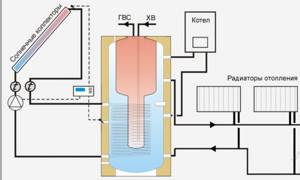
The solar collector is connected to the water supply and a circulation pump. The energy is used to indirectly heat the room.
For hot water supply
There are 2 options for use: for summer and winter.
The first one is suitable for summer residents. They heat water only in summer. Therefore, such an installation has minimal inertia. It is necessary to install the solar collector below the level of the storage tank so that the water circulates naturally.

In winter, antifreeze is used as a coolant fluid, which is poured into a storage tank with a coil. Due to its continuous circulation, the water is constantly heated to the optimal temperature.
Heating + hot water
The essence of the connection diagram is the combination of heating and domestic hot water processes. A double-circuit heat-storing tank with an internal reservoir is used. This helps separate process water from drinking water. For automation, an SC controller is included in the circuit to prevent overconsumption.
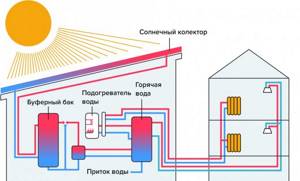
For heating the pool
To warm up a portable or stationary pool, use a submersible pump. It can be replaced with an automated pumping station, which will circulate cold water from the pool, and heated water from the SC.
What does a solar heating system include?
Of course, the modification that a solar heating system undergoes depends primarily on the manufacturer. In addition, the buyer can also select only those elements that are necessary to create high-quality solar heating. However, there are several required elements:
- vacuum solar collector;
- a pump with which the coolant moves to the storage tank;
- controller. This is a control element that monitors the correct functioning of the system;
- hot water tank. Depending on exactly what area needs to be heated, its volume ranges from 500 to 1000 liters of water;
- peak closer. Depending on your preferences, you can choose an electric heating element, a heat pump, or some other source of auxiliary heating.

Composition of solar heating system
Like any other, a solar heating system can serve not only for heating a home. Since some regions experience a fairly large number of sunny days per year (up to 280-290), this allows the use of this type of heating to create a high-quality hot water supply system in the house, which will be used for domestic needs. If we take this factor into account, then we can say with confidence that such solar convectors for heating a house are leaders in efficiency, even despite the rather high cost of the collector and additional equipment.
However, you should take into account the need to connect them even before purchasing a water tank - after all, you may have to purchase a tank with a larger capacity than originally planned.
Installation and cost of connecting a solar collector by specialists
Installing solar collectors is a labor-intensive task. If you have experience in such work, you can do the installation yourself.
Before installation, it is recommended to study the instructions and read information on specialized forums. Installation of the popular IC “Soltek” and Solar Fox can be viewed in a special video instruction.
Installation of the solar collector and its connection to the water supply can be ordered from certified companies. The installation price depends on the region, the minimum amount is 12,000 rubles. The estimate includes external and internal work.
The use of collectors for partial or full heating and hot water supply is a rational solution. This is an environmentally friendly and affordable way to generate energy that will help you save on utility bills.
Polycarbonate manifolds
Sheets of cellular polycarbonate or polypropylene are the main elements that make up such collectors. The collector itself is attached directly to the ends of the sheets. Only in a special covered tin box is it necessary to install such a system. An additional polycarbonate sheet should be used as a cover . You can also make a glass cover, but if there is too much light transmission, the polycarbonate will create a greenhouse effect, so it will look like double glazing. So it’s better to make everything entirely from polycarbonate, so the system will work more stable.
Classification by temperature regime
Solar equipment for the home is often classified by type of coolant. Today, liquid and air systems can be found on the world market. In addition, collectors are divided according to operating temperature conditions, that is, classification is applied according to the maximum heating temperature of the working elements. The following types of systems are distinguished:
- low-temperature - the coolant for solar collectors heats up to 50℃;
- medium temperature - the temperature of the circulating liquid does not exceed 80℃;
- high-temperature - the maximum temperature of the coolant material can rise to 300 degrees.
The first two options are most suitable for home use, while collector models with high-temperature operating conditions are more often used in the manufacturing and industrial sectors of the economy. This is due to the fact that in high-temperature water heating systems the process of transforming solar energy into heat is quite complex. Moreover, such solar installations occupy large areas. Not every owner of a “dacha” property can afford such luxury.
Coolants for solar systems
The main coolant for heating systems is water. However, its use in solar systems is limited by the crystallization temperature of 0°C, which means the use of water as a coolant is limited to climatic zones where there are no negative temperatures. In addition, the salts contained in the water clog the heating surfaces with scale, and the corrosive agent - oxygen - damages the metal parts of heating systems and contributes to the decomposition of the coolant into its component elements. Therefore, a type of coolant was developed for solar systems that is devoid of the above disadvantages.
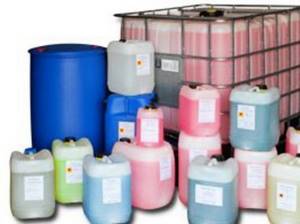
The basis of this coolant is propylene glycol mixed with water that has undergone water treatment in the form of demineralization.
In addition, to reduce the corrosive and decomposing effects of oxygen, antioxidant additives are added to the coolant, the formation of gas bubbles in the liquid is reduced by the addition of defoamers, and stabilizers added to the coolant help keep the solution chemically homogeneous. As a rule, coolants for solar systems are sold ready-made. The concentration of propylene glycogel in them is 40% and higher, which corresponds to a crystallization temperature of -30°C and lower. The acid-base balance (pH) for the finished coolant is maintained in the alkaline zone (≥ 7.0) to reduce the corrosive effect.
When using solar system coolants, you should not mix coolants from different manufacturers, since compositions that are different in both quantitative and qualitative properties can enter into a chemical reaction, rendering the solar system unusable.
Solar energy in the conditions of the current energy and economic crisis is one of the most promising areas of technology aimed at preserving the irreplaceable resources of our planet.
